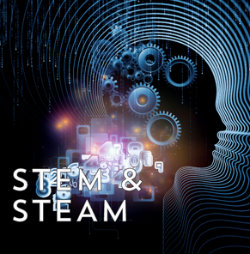Curriculum Conundrum: What Is & Isn’t STEAM?
A MiddleWeb Blog
 It’s 4 a.m. as I’m writing this, and I am NOT a morning person. But I woke up during the night with this recurrent predicament cluttering up my head – again. So I decided to bring it to you for consideration.
It’s 4 a.m. as I’m writing this, and I am NOT a morning person. But I woke up during the night with this recurrent predicament cluttering up my head – again. So I decided to bring it to you for consideration.
Last evening Nancy Flanagan and I were on a Twitter chat to discuss STEM/STEAM for an online course we’ll be teaching in April. I’m the science person and Nancy is the artist/musician. Many of the Twitter participants were art teachers and administrators. They wanted to find out more about STEAM.
I’m thinking that it’s time we work ourselves through this particular STEM permutation. What, exactly, does a well-done STEAM program look like?

Now I’m just trying as hard as my science-oriented brain will allow to figure out how best to integrate the “A” into this process. I tried this once before here, but haven’t reached a clear resolution in my own head.
So please think with me about this STEAM conundrum for a moment. And let me quickly add that, according to my research and my Twitter chat colleagues and STEM peeps, it is a conundrum.
Possible STEAM Guidelines
First, should we apply some basic STEM guidelines to STEAM programs? If we do that, then the principles of a good STEAM program might read like this:
(1) Students gain new skills and a deeper knowledge of science, math and art (all three).

STEAM product?
(2) Science, math and art are integrated.
(3) Science, math and art are collectively applied to a real problem.
(4) The engineering design process is the driver for finding solutions to the identified problem.
(5) Engaging, inquiry-based instructional approaches are used and research is incorporated.
(6) Students work in teams to find solutions, and multiple right solutions are possible.
(7) Technology is used or created. (Remember the definition of technology – anything produced by humans in response to a need or want.)
If the program doesn’t include those guidelines, how could it qualify as a true STEAM program? How could it be said to help prepare students with 21st century life and workforce skills that include a deeper content knowledge in science and math, along with problem-solving skills, teamwork, and critical thinking?
Art certainly occupies a real and valid place at the STEM table since the creative arts play an integral role in nearly every invention we engineer. But, keeping in mind the guidelines listed above, does having a program that connects just art and science, or uses computers to generate graphics, actually qualify as STEAM?
How might a truly integrated STEAM class operate?

In those particular scenarios, art plays a practical, applied role. Students apply art principles to improve the choice of materials, appearance, ease of use and/or marketing of products created.
Now let’s look at this from the perspective of an arts teacher. Let’s say a band needs an instrument to produce unusual sound effects during a piece of music. Let’s say the kids want to call it the Mugglesplatz. What materials would be best for constructing this instrument? What size and attributes would give it the right pitch and sound quality? That is a real problem that a STEAM team that includes musical artists might work together to solve.
Perhaps a group of theatre students need a special effect – maybe a spooky apparition to mysteriously appear at center stage. This would create a good opportunity for science and math students to work on the technical aspects in collaboration with performing arts students.
How do we STEAM?

Let me assure you that I don’t have answers. I welcome better ideas about what a bonafide STEAM program would look like. I do know this: simply “throwing in the arts” doesn’t serve students and teachers in any of these important subjects. I want to be able to define clearly how students in STEAM courses work together in a truly integrated science, technology, engineering, arts and math program.
If you have knowledge or ideas on this topic, please chime in. Keep in mind that we’re looking for STEAM projects in which the S. T. E. A. & M. are coordinated and integrated. One point: STEAM is to help students see strong interdisciplinary dependencies – and to use these disciplines to solve real world problems.
Nancy and I can both use your comments to inform our online course. If you have something too long to post in the comments here, send it as an attachment to jollyanne@gmail.com. Or, as a real treat, if you have a blog, you might post your thoughts there and then post the link below in the comments, so we can visit and read your blog.
The STEAM area is still hazy for me – can you help dispel the fog?





























